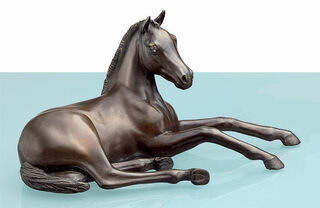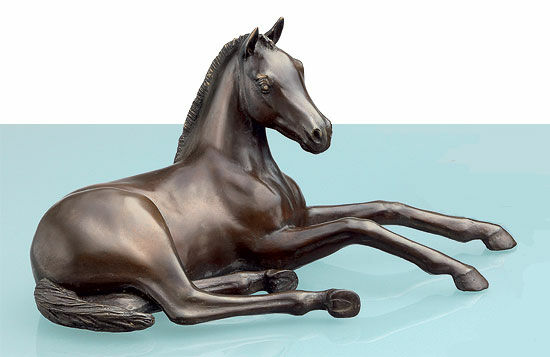Horse sculpture Arabian foal "Young Dream", bronze
Horse sculpture Arabian foal "Young Dream", bronze
Quick info
ars mundi Exclusive Edition | limited, 199 copies | numbered | signed | bronze | hand-patinated and -polished | size 22 x 12 x 10 cm | weight 1.3 kg
Detailed description
Horse sculpture Arabian foal "Young Dream", bronze
Annette Diekemper has been an equestrian for 25 years and is a great devotee of classical horsemanship. With great sensitivity, she captures all the versatility of the fascinating animals in breed, temperament and charisma and can convey them to the viewer in a lively and unadulterated way. The sculptress reproduces the muscular play of this majestic creature down to the last detail - a masterpiece of modern animal art.
Fine bronze sculpture, cast by hand using the Lost-Wax-Process, patinated and polished by hand. Limited edition 199 copies, numbered and signed. Size 22 x 12 x 10 cm, weight 1.3 kg. ars mundi Exclusive Edition.
This object is part of the following sets
Customer reviews
Schöner als erwartet !
About Annette Diekemper
Born in Gütersloh, Germany in 1959, sculptor Annette Diekemper's naturalistic works follow the art of the great animaliers of Jules Mêne and Antoine Barye, whose designs enjoyed great success in the Paris salons.
Her concern is to depict animals in their appearance and behaviour as authentically as possible, capturing a snapshot of the beauty of nature.
An alloy of copper with other metals (especially with tin) used since ancient times.
When casting bronze, the artist usually applies the lost-wax technique which is dating back more than 5000 years. It's the best, but also the most complex method of producing sculptures.
First, the artist forms a model of his sculpture. It is embedded in a liquid silicone rubber mass. Once the material has solidified, the model is cut out. The liquid wax is poured into the negative mould. After cooling down, the wax cast is removed from the mould, provided with sprues and dipped into ceramic mass. The ceramic mass is hardened in a kiln, whereby the wax flows out (lost mould).
Now we finally have the negative form, into which the 1400° C hot molten bronze is poured. After the bronze had cooled down, the ceramic shell is broken off and the sculpture is revealed.
Now the sprues are removed, the surfaces are polished, patinated and numbered by the artist himself or, to his specifications, by a specialist. Thus, each casting becomes an original work.
For lower-quality bronze castings, the sand casting method is often used which, however, does not achieve the results of a more complex lost-wax technique in terms of surface characteristics and quality.
Graphic or sculpture edition that was initiated by ars mundi and is available only at ars mundi or at distribution partners licensed by ars mundi.
Term for an art object (sculpture, installation), which is produced in multiple copies in a limited and numbered edition according to the artist‘s will.
Artist's multiples have been called the most accessible and affordable art on the market.
A plastic work of sculptural art made of wood, stone, ivory, bronze or other metals.
While sculptures from wood, ivory or stone are made directly from the block of material, in bronze casting a working model is prepared at first. Usually, it is made of clay or other easily mouldable materials.
The prime time of sculpture after the Greek and Roman antiquity was the Renaissance. Impressionism gave a new impulse to the sculptural arts. Contemporary artists such as Jorg Immendorf, Andora, and Markus Lupertz also enriched sculptures with outstanding works.



